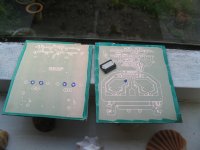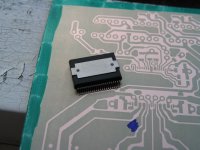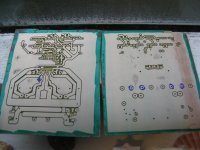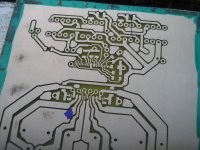JohnG, what are the input impedance values of the classd vs the sure, and what is the presumed output impedance of your source? Maybe the classd has a much lower input impedance which could create a HF filter...
Ok, this is what I, a flawed organic meat puppet, think I am hearing through my
possibly tone deaf ears:
The "Class D Audio" images well up to the upper mid-range then it gets a little diffuse in the tweeter side of cymbals and high frequency transients.
However, voices, snare drums, horns etc image very well.
The Sure had great imaging through out the entire audio range. An visual analogy would be looking at a fireworks display and being able to see the exact point and width of each burst. Its almost as if the Sure had tighter damping and control over the tweeters.
Is this output filter related stuff? Could using a power supply up closer to 50V improve the imaging. I suspect so. Wasn't inclined to mention this cause I know moving a speaker to a slightly different position or setting a different e.q can turn things completely around.
Then again, the last real fireworks here WAS the Sure amp. Maybe this is like eulogizing a dead uncle.
hah. great post.
impedance could be a factor. I'm driving 4 ohm mtm's with my classd and I found there was a roll-off on the high end. looking at the pdf for the IR board, the 4ohm response curve rolls off much sooner than the 8 ohm. Dunno if this applies in your case. That said, the Sure does perform as you describe vs. the classd, but I found that after a time I was too busy admiring the sure's performance instead of the music.
Is this output filter related stuff?
Quite possibly, yes. The output filter can dramatically alter the top end balance of a system.
If the Class D module is a close copy of the TI evaluation module, then page 14 of the datasheet shows you the frequency response with respect to the input impedance of the loudspeakers.
Could using a power supply up closer to 50V improve the imaging. I suspect so. Wasn't inclined to mention this cause I know moving a speaker to a slightly different position or setting a different e.q can turn things completely around.
I would doubt this. As long as the amplifier isn't clipping, it's performance should remain the same regardless of what voltage you feed it. In fact it might sound better at a lower voltage as the radiated and potentially interfering switching garbage would be reduced somewhat.
Then again, the last real fireworks here WAS the Sure amp. Maybe this is like eulogizing a dead uncle.
This could be entirely related to the frequency response variations caused by different output filters. I'd play around with a little bit of subtle EQ and see if I could readjust the balance.
JohnG, what are the input impedance values of the classd vs the sure, and what is the presumed output impedance of your source? Maybe the classd has a much lower input impedance which could create a HF filter...
If ClassD's module is similar to the TI evaluation board then the input impedance is around 100k I think.
where's all the pics of these projects?
I've got some pics closely at hand, although nothing really exciting. Just the PCBs before and after etching 🙂
Attachments
Mark,
You spoke of a shootout that was going to happen around the first of the year. Did it happen? I'm especially interested in how the IR based amp that Tom was going to send you did. Thanks
boone
You spoke of a shootout that was going to happen around the first of the year. Did it happen? I'm especially interested in how the IR based amp that Tom was going to send you did. Thanks
boone
Ok, this is what I, a flawed organic meat puppet, think I am hearing through my
possibly tone deaf ears:
The "Class D Audio" images well up to the upper mid-range then it gets a little diffuse in the tweeter side of cymbals and high frequency transients.
However, voices, snare drums, horns etc image very well.
The Sure had great imaging through out the entire audio range. An visual analogy would be looking at a fireworks display and being able to see the exact point and width of each burst. Its almost as if the Sure had tighter damping and control over the tweeters.
Is this output filter related stuff? Could using a power supply up closer to 50V improve the imaging. I suspect so. Wasn't inclined to mention this cause I know moving a speaker to a slightly different position or setting a different e.q can turn things completely around.
Then again, the last real fireworks here WAS the Sure amp. Maybe this is like eulogizing a dead uncle.
This sounds quite similar to what I am experiencing with the 300w TI based amp from Class D. I have been listening to it for about a month now but I don't really feel like I am getting the most out of it, or maybe I am and it just isn't my taste. I have to say I preferred the sound of the 2x100 Sure board with just a 50K Shallco attenuator on it. I did the most basic mods to the front end of the sure(upgrading 2.2uf caps). I don't know if it is the opamps in the front end of the Class D amp but I am having a hard time warming to it. The other factor is that it apparently really needs to be used with a preamp, according to an email I received from Class D. I would prefer to go without the added noise of a preamp stage.
I am using a 48v Meanwell supply with the amp and it certainly doesn't seem to break a sweat with any of my speakers. I have tried my Yaqin MS-12B pre with it and was quite disappointed by the combo. I expected the two to go very well together but there seems to be some "antisynergy" going on(I can make up words, right?).
I'm not sure what to do with it at this point. I am not overly fond of the sound as it is and don't know if adding a different component is going to change that. The only thing I can think of is to try a buffer in front of it (B1 or otherwise) but I don't know how well that would work(i.e. if it would have sufficient gain).
This sounds quite similar to what I am experiencing with the 300w TI based amp from Class D. I have been listening to it for about a month now but I don't really feel like I am getting the most out of it, or maybe I am and it just isn't my taste. I have to say I preferred the sound of the 2x100 Sure board with just a 50K Shallco attenuator on it. I did the most basic mods to the front end of the sure(upgrading 2.2uf caps). I don't know if it is the opamps in the front end of the Class D amp but I am having a hard time warming to it. The other factor is that it apparently really needs to be used with a preamp, according to an email I received from Class D. I would prefer to go without the added noise of a preamp stage.
I am using a 48v Meanwell supply with the amp and it certainly doesn't seem to break a sweat with any of my speakers. I have tried my Yaqin MS-12B pre with it and was quite disappointed by the combo. I expected the two to go very well together but there seems to be some "antisynergy" going on(I can make up words, right?).
I'm not sure what to do with it at this point. I am not overly fond of the sound as it is and don't know if adding a different component is going to change that. The only thing I can think of is to try a buffer in front of it (B1 or otherwise) but I don't know how well that would work(i.e. if it would have sufficient gain).
I don't made it but a forum user, Wushuliu, wrote in italian forum:
One last recommendation for this amp: I highly, highly, highly recommend replacing the 2 .47 uf .1 uf Epcos and output filter caps (the big blue caps). I have replaced mine with the well-regarded Dayton film / foil bypass caps. Cost: $ 5. I no longer need the buffer. All the issues with this amp that I believed needed to be corrected by the buffer or preamp are now gone.
Parts-Express.com: Dayton DFFC-0.47 0.47uF 400V By-Pass Capacitor | polypropylene capacitor polypropylene PAC PA low pass foil film and foil dayton capacitor caps cap ac 47uf .47uf
It makes sense as the Epcos are basic low-cost caps. I used them to replace the cheap polyester caps in the buffer. I would have used better but there was no room on the buffer PCB. They are okay, but nothing special.
Obviously an amp like this needs better than these caps for the output filter (as anyone who built tripaths w / input and output filter caps caps knows).
The amp now sounds outstanding. Near-perfect in my setup. It is a difference that would be audible to anyone. It is totally transparent and very, very clean.
Make sure to use a good iron, the PCB is thick so take your time.
I can not recommend this enough. Any decent cap will be better than the Epcos, so you can spend as much or little as you want.
I think this is it for me as far as this amp is concerned. I do not think it can sound any better (well. ..):
Polydomes
Hey msb64,
Nice speakers. I have a pair of 6's myself. I remember hearing the 8's and 9's a while back. They have a very big sound with real nice highs if I remember correctly.
I notice your polydomes have clouded over. Mine have done the same thing. They still sound good to me. But, I think it's getting close to where some kind of replacement might be in order -- can't find those polydome diphragms any more.
You are totally right -- these guys are power hungry. My preference would be to biamp them.
Regards,
Steve
Hey msb64,
Nice speakers. I have a pair of 6's myself. I remember hearing the 8's and 9's a while back. They have a very big sound with real nice highs if I remember correctly.
I notice your polydomes have clouded over. Mine have done the same thing. They still sound good to me. But, I think it's getting close to where some kind of replacement might be in order -- can't find those polydome diphragms any more.
You are totally right -- these guys are power hungry. My preference would be to biamp them.
Regards,
Steve
I finally got a chance to test the amp with the Infinity Kappa 8s.
Although it is a powerful little amp, the 8s are just a little too much for it.
Heavy and low frequency bass passages can send the amp into protection mode.
That is not really surprising though, the 8s and 9s were known as amp killers back in the 90s as they can easily dip down into the 2 ohm and under impedance range. Most integrated amps and receivers back then just wouldn't cut it with these power hungry units.
The track "End Credits" for the soundtrack from Apollo 13 immediately shut down the amp several times, even at medium listen levels, but to be fair that particular track has a very wide dynamic range.
The track "Lets Groove Tonight" by Earth Wind And Fire would also shut down the amp on bass passages when played at medium/high levels.
Each time the amp did trip, switching it to standby mode and then turning back on reset it with no issues. A low frequency cutoff adjustment on the preamp would go a long way to making this amp work with speakers such as these.
I found the midrange performance to be good, but the upper end is a bit off with some slurring of s's and does become fatiguing at higher sound levels.
I have to admit though, I was impressed on how well it does sound out-of-the-box, especially considering the low cost. I know from personal experience that most equipment responds very well to tweaks such as bypass caps, power supply upgrades etc, so I consider this to be a diamond in the rough. Even after several hours of running at normal/medium listening levels, it barely gets warm. I am very happy with it, and looking forward to seeing what kind of improvements I can get out of it.
Btw, checkout the bread-board design, 2 x 8 spruce to be exact 🙂
I don't made it but a forum user, Wushuliu, wrote in italian forum:
One last recommendation for this amp: I highly, highly, highly recommend replacing the 2 .47 uf .1 uf Epcos and output filter caps (the big blue caps). I have replaced mine with the well-regarded Dayton film / foil bypass caps. Cost: $ 5. I no longer need the buffer. All the issues with this amp that I believed needed to be corrected by the buffer or preamp are now gone.
Parts-Express.com:*Dayton DFFC-0.47 0.47uF 400V By-Pass Capacitor | polypropylene capacitor polypropylene PAC PA low pass foil film and foil dayton capacitor caps cap ac 47uf .47uf
It makes sense as the Epcos are basic low-cost caps. I used them to replace the cheap polyester caps in the buffer. I would have used better but there was no room on the buffer PCB. They are okay, but nothing special.
Obviously an amp like this needs better than these caps for the output filter (as anyone who built tripaths w / input and output filter caps caps knows).
The amp now sounds outstanding. Near-perfect in my setup. It is a difference that would be audible to anyone. It is totally transparent and very, very clean.
Make sure to use a good iron, the PCB is thick so take your time.
I can not recommend this enough. Any decent cap will be better than the Epcos, so you can spend as much or little as you want.
I think this is it for me as far as this amp is concerned. I do not think it can sound any better (well. ..):
Are you referring to the Sure or the Class D amp?
Are you referring to the Sure or the Class D amp?
250W ClassD amp w/ IR chip...
250W ClassD amp w/ IR chip...
Can I ask what you are using for a power supply with the IR amp?
Can I ask what you are using for a power supply with the IR amp?
I'm using the PS and toroid that came w/ the kit I purchased. It's the smaller of the two PS that Class D offers. The toroid is huge. And replacing the output caps is recommended. I don't know if this is related to the issues you're having, but just like w/ the Sure mods you get a big improvement in sound quality if you use decent caps.
I just threw my 120 wpc in a case made from some bamboo scrap flooring i had till something better materializes. I am very impressed with its huge soundstage and liquid sound. The bass seems to have improved over the last few days and is better than i hoped, and the highs are less edgy now.
Does anyone have photos of the cap change? I found the board a little challanging to work on, how difficult was the cap swap?

Does anyone have photos of the cap change? I found the board a little challanging to work on, how difficult was the cap swap?

I just threw my 120 wpc in a case made from some bamboo scrap flooring i had till something better materializes. I am very impressed with its huge soundstage and liquid sound. The bass seems to have improved over the last few days and is better than i hoped, and the highs are less edgy now.
Does anyone have photos of the cap change? I found the board a little challanging to work on, how difficult was the cap swap?
QUOTE]
Swapping the caps on this board is a challenge, yes. The solder does not melt easily and you have to be careful about lifting pads. I ended up lifting a lot of the pads on the top side, but as long as you solder underneath you're fine.
Here are some links to pics I posted on another forum.
http://i10.servimg.com/u/f10/14/60/15/31/img_1810.jpg
http://i10.servimg.com/u/f10/14/60/15/31/img_1812.jpg
I'm no expert, but it seems from looking over the IRS2092 pdf and the IRAUDAMP7 pdf- as well as some references in other threads, that the input impedance for the Class D IR amps is around 3k ohms.
So much for my 25k volume pot passive preamp. Looks like it's time to build a B1 Buffer...
So much for my 25k volume pot passive preamp. Looks like it's time to build a B1 Buffer...
as well as some references in other threads, that the input impedance for the Class D IR amps is around 3k ohms.
Then I sure hope there is a buffer
- Status
- Not open for further replies.
- Home
- Amplifiers
- Class D
- Class D Audio, Who are these guys?



